Hyundai Santa Fe: twenty-five years since the birth of a saga

In the late 1990s, Hyundai embarked on a transformation by investing heavily in quality, design, and manufacturing to become the globally recognized Korean brand it is today.
Since the 1980s, the automobile market had been dominated by minivans. The Chrysler Voyager and the Renault Espace had changed the automotive landscape. But "fashion is what goes out of fashion," as we know, and in the new century, cars with all-terrain looks and family appeal began to be introduced. While they wouldn't conquer jungles or deserts, they certainly conquered the landscape of cities and highways.
It was a new trend, and little by little, many car manufacturers without experience in this sector opted for the "light" off-road vehicles we've come to know as SUVs and now as crossovers. Hyundai did have some experience—it had been producing the Galloper, a second-generation Mitsubishi Montero, since 1991—but it hadn't created a model of its own in this segment.
And at the 1999 Detroit Auto Show, the Korean brand unveiled the Santa Fe to the public, a model with a Spanish name borrowing from the capital of New Mexico, symbolizing escape and great adventure, but also the desert and therefore the off-road environment. Its European debut came at the 2000 Geneva Motor Show, at a time when Hyundai dealerships in the Old Continent were only selling the Sonata sedan and the small Pony, the ancestor of the Accent. So the arrival of the Santa Fe not only attracted attention and changed the perspective on the brand, but also opened the door to a new type, a new style of automobile.
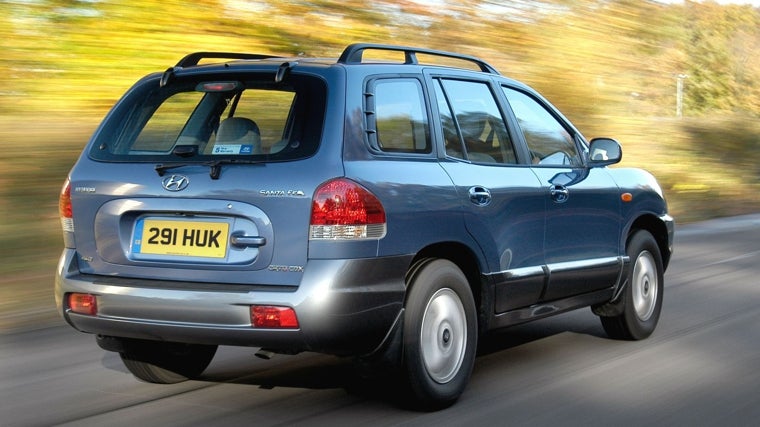 A body with very rounded lines, halfway between a family car and an SUV.
GS
A body with very rounded lines, halfway between a family car and an SUV.
GS
Based on the Sonata platform of the era, it measured 4.5 meters long, with a body with rounded lines and integrated bumpers, a striking, bulging hood, and a tailgate that opened independently of the rear window. Although its design wasn't a masterpiece, that blend of station wagon and off-roader was spot on: it was the car many European customers had been waiting for for everyday family use.
The interior was notable for its generous space and striking equipment, far exceeding what one might expect for its price at the time: air conditioning, electric windows, mirrors, sunroof, and a CD player, among other features.
And safety, too. It's worth noting that the Santa Fe was preceded by its strong results in American NHTSA safety tests (the equivalent of the European Euro NCAP), where it outperformed many of its direct rivals.
Mechanically, under the hood it had the same gasoline engines as the American market. The first was a 2.7-liter V6 producing 179 hp, the second was a 2.0-liter four-cylinder engine with 136 hp. But Europe was experiencing the diesel craze (Brussels had yet to begin its demonization), hence the inclusion of a 116-hp 2.0-liter diesel that accelerated from 0 to 100 km/h in 13.3 seconds and reached 172 km/h. Depending on the version, these engines could be paired with a 5-speed manual transmission or a 4-speed automatic, and a permanent four-wheel drive transmission.
Incidentally, this first-generation Santa Fe will serve as the basis for a very special unit. Hyundai began developing fuel cell vehicles in 1998, and in 2000 presented its first prototype, the Santa Fe FCEV. It featured a 350-bar hydrogen tank (located under the trunk) and a 75 kW fuel cell mounted under the rear seats. It had a range of 180 kilometers and a top speed of 124 km/h (77 mph). In the 2001 Challenge Bibendum, the Santa Fe FCEV won gold medals in both the emissions and noise tests, and received silver medals for its performance in the slalom and fuel efficiency tests.
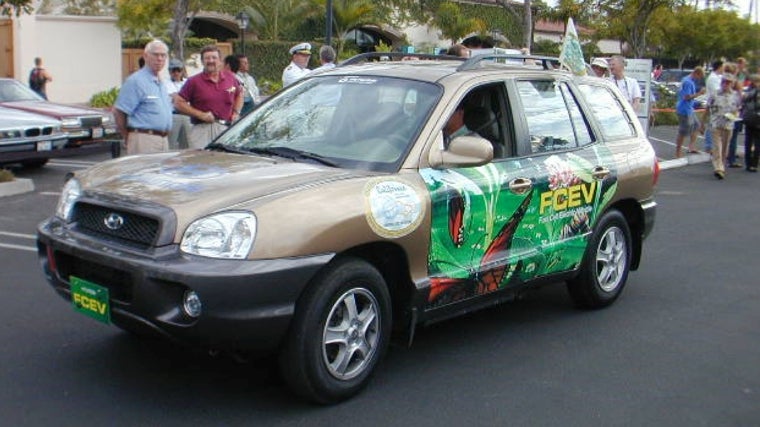 The hydrogen-powered FCEV prototype
GS
The hydrogen-powered FCEV prototype
GS
The FCHEV variant, introduced at the 2003 Challenge Bibendum, featured a braking energy recovery system to provide greater fuel efficiency.
It was a first step in work that will make Hyundai the first automaker to apply fuel cell systems to all commercial vehicle models by 2028, and expects a fuel cell electric vehicle (FCEV) price comparable to that of a battery electric vehicle (BEV) by 2030. The Group will apply fuel cell systems to all types of mobility and extend the technology to all other aspects of society, including homes, buildings, and power plants as energy solutions.
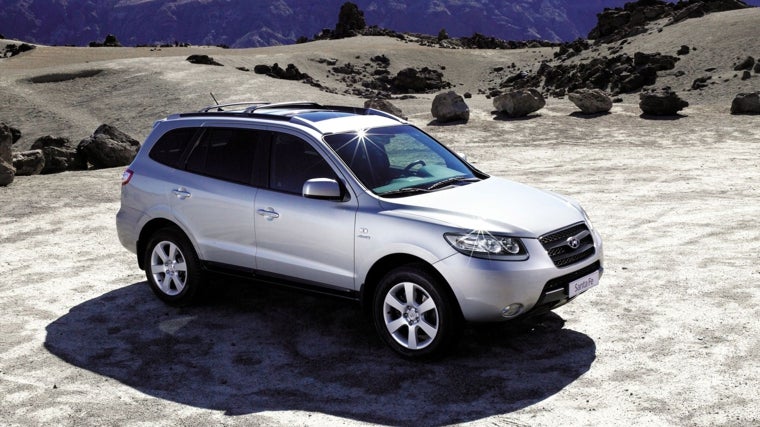 The second generation appears in 2006
GS
The second generation appears in 2006
GS
But let's get back to our story. In January 2006, a second-generation Santa Fe was launched, also at the Detroit show, a very important market for the brand.
Its exterior style has changed completely, and the interior has seen a notable leap in quality. But there were even more new features. One of them was that, for the first time, a third row of seats is available as an option. As for equipment, it comes standard with electronic stability control (ESC), ABS, curtain airbags in all rows of seats, a tire pressure sensor, and active head restraints. Without a doubt, Hyundai, from the outset, wanted to differentiate itself at this level, even in its entry-level versions.
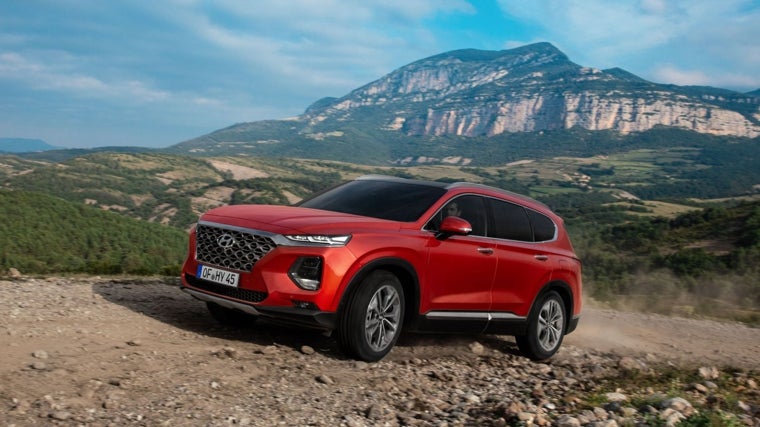 The third generation would arrive in 2012
GS
The third generation would arrive in 2012
GS
The third generation of the Santa Fe arrived in 2012 and features a very different aesthetic design that reflects the brand's new stylistic direction, known as "Storm Edge."
Available in a five-seat, seven-passenger configuration, the Santa Fe offers emergency brake assist, among other features.
In 2019, building on the success of its previous generations, Hyundai launched the fourth, which stands out for its original exterior lines, a spacious seat, and increasingly more extensive equipment, including Rear Occupant Alert (ROA) to detect any movement of children or pets in the rear seat when the driver leaves the vehicle.
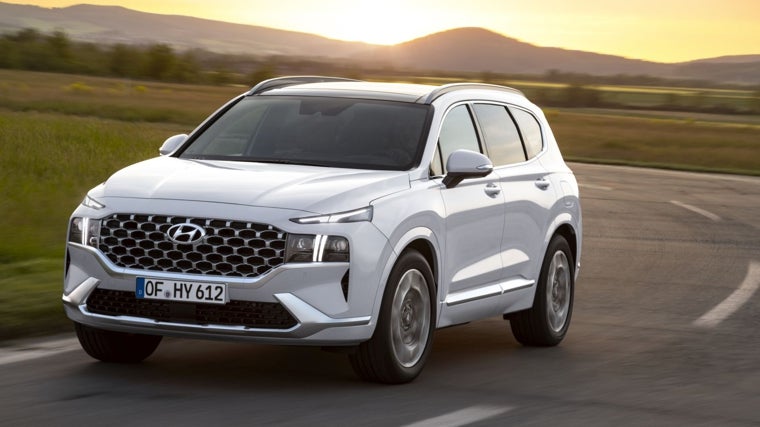 The fourth generation was born in 2019.
G. s.
The fourth generation was born in 2019.
G. s.
Another safety feature was Rear Cross Traffic Alert (RCCA), which scanned the area behind the vehicle 180° and applied the brakes if necessary to avoid a collision. And for the first time, a head-up display...
And now, twenty-five years after that first Santa Fe, we're behind the wheel of a new generation, the fifth, which was just a few months old: it was unveiled at the end of last year. Spectacular in terms of dimensions—no less than 4.83 meters long (six centimeters more than the previous model)—and aesthetics, with many other changes, including a new engine range.
From the outset, it stands out for its distinctive appearance, unlike any of its rivals. Parallelepiped shapes, right angles, a sharply cut rear end, a long, horizontal waistline, a straight hood, a long rear overhang, and H-shaped front and rear daytime running lights... Bold, no doubt, but balanced, this design by the team of Spanish Eduardo Ramírez, Chief Designer of Hyundai Design Europe.
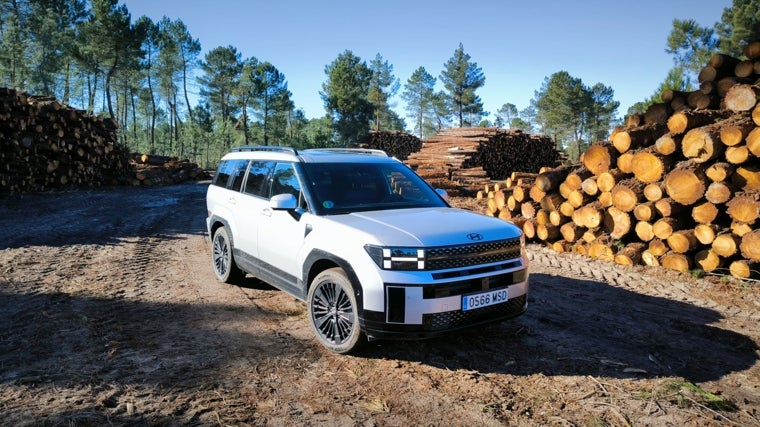 The fifth generation, designed by the team of the Spanish Eduardo Ramírez, represents a radical change in all aspects
GS
The fifth generation, designed by the team of the Spanish Eduardo Ramírez, represents a radical change in all aspects
GS
The new Hyundai Santa Fe is available, always in 7-seat version, as a 253 hp PHEV plug-in hybrid (standard all-wheel drive and "0" label) or as a 215 hp HEV hybrid, with front-wheel drive or 4x4: the latter corresponding to the unit tested.
Having 215 hp for 1.9 tons may seem fair. Fortunately, the 265 Nm of torque from the 1.6-liter turbocharged gasoline engine and the 264 Nm permanent magnet synchronous electric motor produce 367 Nm, which does their job well. Although we could have wished for a slightly more generous electric assistance than these somewhat timid 64 hp. Everything is mated to a 6-speed automatic gearbox with a management system that prioritizes flexibility and driving comfort.
In fact, the on-board atmosphere is relaxing, the seats are excellent, the interior generous, and the storage spaces are as numerous as they are ample. The fact that the gearbox controls have migrated to the steering column has freed up space for a very spacious center console, capable of accommodating two smartphones side by side, each with its own ventilated induction charger. The second-row seat (60/40) slides generously and its backrests are tilt-adjustable. Not to mention the trunk space, at least in the 5-seat configuration, capable of accommodating everything when going on vacation. But we bet that, loaded to the roof, the Santa Fe's gasoline/electric engine combination will have to work hard, especially if the terrain is mountainous or hilly. Because when used under heavy loads, the 4-cylinder engine becomes audible and its sound is not refined. Fuel consumption can also vary significantly. However, after a week of testing, mostly empty and conducted at a reasonable pace, we managed to achieve around 7 liters per 100 km, a good result considering its size.
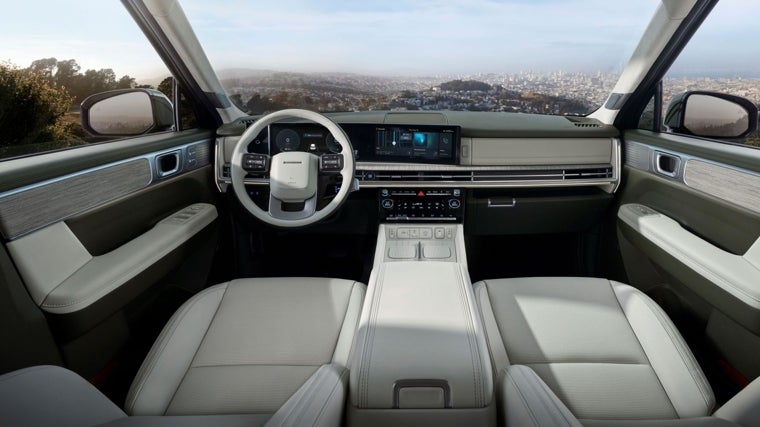 Interior of the new Santa Fe, with a technological dashboard
GS
Interior of the new Santa Fe, with a technological dashboard
GS
The Hyundai Santa Fe certainly isn't cheap (we're talking prices exceeding €58,000 for the most affordable versions). But those who can afford to overcome this handicap will discover a large SUV that dares to be different and also offers genuine objective qualities. These include spaciousness, ride comfort, on-board comfort, trunk space, attractive interior design, and standard equipment, both in terms of comfort and safety.
But beware, it doesn't have pure off-road capabilities, especially in the two-wheel drive (front) configuration, and its towing capacity is limited to 1,150 kg (braked). It prefers to play the card of the attractive, quiet, and practical family off-roader. And it does so very well, continuing the saga of a model whose success and history are closely linked to the Korean giant's foray into Europe.
ABC.es





